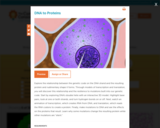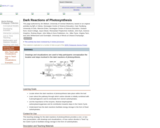
Este video explica cómo ordenar moléculas pequeñas con una técnica denominada cromatografía en columna.
- Subject:
- Biology
- Science
- Material Type:
- Lecture
- Provider:
- LabXchange
- Provider Set:
- LabXchange Videos
- Date Added:
- 10/25/2023

Este video explica cómo ordenar moléculas pequeñas con una técnica denominada cromatografía en columna.

Esta simulação explora como crescer células bacterianas que foram
transformadas com um plasmídeo recombinante e avaliar a expressão do
gene de interesse usando meios seletivos.

Cette animation décrit comment les bactéries sont cultivées en laboratoire et les différentes phases de la croissance bactérienne, comprenant la latence, la croissance exponentielle, la latence et la mort.

En este video, los profesores Dave y Mary analizan cómo usar una micropipeta y el motivo por el cual este equipo es una herramienta esencial en el laboratorio.

Este interactivo desplegable demuestra el modo en que las enzimas de
restricción (también denominadas endonucleasas) funcionan y el motivo por el
cual se pueden utilizar como herramientas para analizar el ADN y crear
plásmidos recombinantes.

This scrollable interactive takes users on a tour of the DNA double helix, explaining how nucleotide base pairing leads to DNA's unique shape.

In this video, Monique demonstrates how to perform a ligation reaction in the lab.

Bu simülasyon, sanal bir laboratuvar ortamında ligasyon reaksiyonu gerçekleştirme ile ilgili pratik yapma fırsatı sağlamaktadır. Bu proseste, bir restriksiyon enzimi sindiriminden üretilmiş komplementer küt veya yapışkan uçların kullanımıyla iki DNA parçacığını eklemek için DNA ligaz enzimi kullanılır.

This pathway includes an introduction to how genetic information is replicated and expressed to form proteins. For a deeper look at this topic, we recommend the pathways DNA Structure and Function and Genes and Proteins from the OpenStax textbook Biology for AP® Courses.

Deze simulatie biedt u de kans om een ligatiereactie te oefenen in een virtuele labomgeving. Dit proces maakt gebruik van het enzym DNA-ligase om twee DNA-fragmenten vast te maken met behulp van complementaire stompe of kleverige uiteinden, gegeneerd uit een digestie van restrictie-enzymen.

Explore the relationship between the genetic code on the DNA strand and the resulting protein and rudimentary shape it forms. Through models of transcription and translation, you will discover this relationship and the resilience to mutations built into our genetic code. Start by exploring DNA's double helix with an interactive 3D model. Highlight base pairs, look at one or both strands, and turn hydrogen bonds on or off. Next, watch an animation of transcription, which creates RNA from DNA, and translation, which 'reads' the RNA codons to create a protein.

This online interactive module of 10 pages or frames integrates textual information, 3D molecular models, interactive molecular simulations, and embedded assessment items to guide students in understanding the copying of DNA base sequences from translation to transcription into proteins within each cell. The module divides the exercises in to Day 1 and Day 2 time frames. Teachers can view student assessment responses by assigning the module within a class created within the Molecular Workbench application. This Java-based module must be downloaded to each computer.

このシミュレーションは、バーチャルラボ環境でライゲーション反応の実施を練習する機会を提供します。このプロセスでは DNA リガーゼという酵素を使い、制限酵素消化で得られる相補的な平滑末端または粘着末端を用いて DNA 断片 2 つをつなげます。

이 시뮬레이션은 가상 실험실 환경에서 리게이션 반응 실험을 실습할 수 있는
기회를 제공합니다. 이 과정에서는 제한효소 절단으로부터 생성된 상보적인
평활 말단 또는 점착성 말단을 사용하여 2개의 DNA 단편을 부착하기 위해
효소인 DNA 리가아제를 사용합니다.

Students learn how the process of soil solarization is used to pasteurize agricultural fields before planting crops. Soil solarization is a pest control technique in agriculture that uses the sun’s radiation to heat the soil and eliminate unwanted pests that could harm the crops. The approach is compared to other pest control methods such as fumigation and herbicide application, highlighting the respective benefits and drawbacks. In preparation for the associated hands-on activity on soil biosolarization, students learn how changing the variables involved in the solarizing process (such as the tarp material, soil water content and addition of organic matter) impacts the technique’s effectiveness. A PowerPoint® presentation and pre/post-quiz is provided.

The dark reactions of photosynthesis (Calvin Cycle) are presented in this learning experience to show where these processes take place in the plant as well as the specific reactions involved.

This three-act film tells the story of the detective work that solved the mystery of what caused the disappearance of the dinosaurs at the end of the Cretaceous period. Shot on location in Italy, Spain, Texas, Colorado, and North Dakota, the film traces the uncovering of key clues that led to the discovery that an asteroid struck the Earth 66 million years ago, triggering a mass extinction of animals, plants, and microorganisms. Science practices in geology, physics, biology, chemistry and paleontology all contributed to the solution to this compelling mystery. Lesson plans are included that have students identify evidence and construct an explanation to tie it together. Summary questions are included at the end and a class discussion is recommended. (This activity will be the only one evaluated in this review.) Another resource is Finding the Crater where students visit different K-T boundary sites. There are also lessons where students analyze various characteristics of the asteroid such as its size and energy, chemical data about the asteroid, and the iridium fallout from an asteroid impact. A hands-on activity where students study the differences in foraminifera fossils below and above the K-T boundary is also included as well as an article that outlines more details about each of the discoveries covered in the film. You can view the film on the website or HHMI will send you a free DVD. Lesson plans including teacher notes and a student handout can be found at http://www.hhmi.org/biointeractive/following-trail-evidence.

This video segment, adapted from Decision in the Streets by civil rights filmmaker Harvey Richards, portrays the interracial protests that took place in San Francisco in 1963-64.

This video explains the different ways the gene editing complex CRISPR-Cas9 is delivered into cells.

This lab video demonstrates how to run a typical protein gel in detail. This method is also called SDS-PAGE and separates proteins by molecular weight.